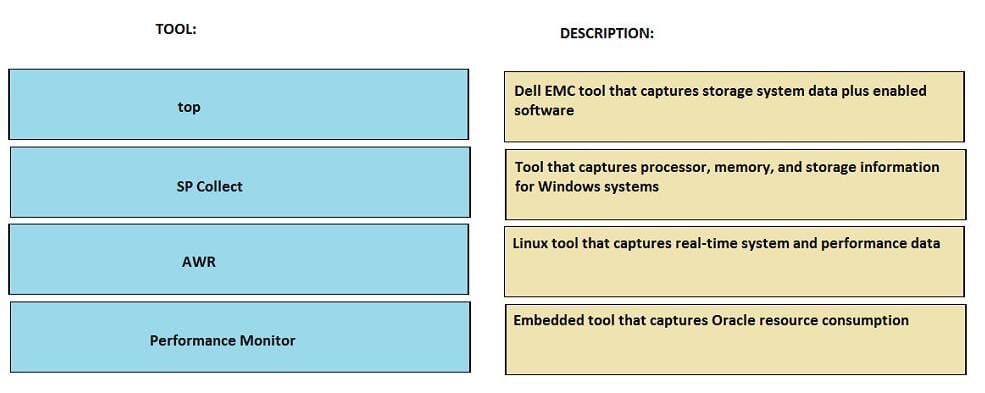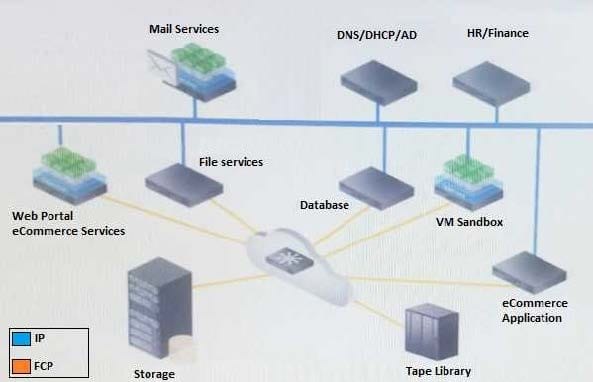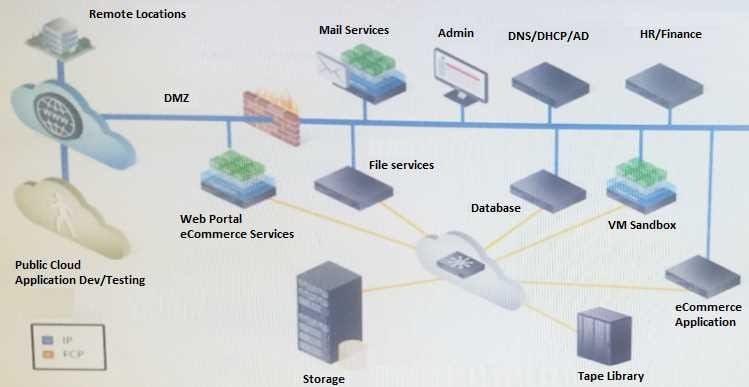DES-2T13 Online Practice Questions and Answers
DRAG DROP
Match each tool with its associated description.
Select and Place:

What are key focus areas of requirements gathering for a cloud design?
A. Automation and multi-tenancy
B. Data growth and consolidation
C. Multi-tenancy and data growth
D. Consolidation and automation
An organization wants to provide its developers the ability to deploy VMs. These VMs have software and libraries installed that are used to develop applications. Each VM will be configured with the same IP address and will be able to download application code from a central server. What will be included in the design to support these requirements?
A. VXLANs and an OS firewall
B. VXLANs and virtual firewall appliances
C. VLANs and virtual IDS appliances
D. VSANs and virtual IDS appliances
A cloud architect is tasked with designing a backup using the Remote with Cloud Gateway Deployment Model. What is a design consideration?
A. Replication settings should be driven by organizational requirements around RPO
B. Backup servers are required to communicate with cloud storage interfaces
C. Larger initial backup sets may take long times to complete delivery
D. Gateways must contain backup software to offload backup server tasks
You are designing the VLANs for a CI cloud. You want to separate the LAN traffic to prevent oversubscription. What are the traffic categories you should use?
A. Storage, Management, and Connectivity
B. Operations, Management, and Production
C. Test, Management, and Production
D. Operations, Production, and Test
A company has the following requirements: Modular building blocks Scalability In-house management solution No physical SAN What type of infrastructure would meet these requirements?
A. Cloud-in-a-Box
B. Converged
C. Traditional
D. Hyper-Converged
An organization wants to deploy cloud applications using block storage. The architect has included a HCI solution in the cloud design. Which requirements must have led to including this solution in the design?
A. Acquire additional storage array Combine storage and application processing using a spine/leaf topology
B. No additional storage arrays to be acquired Separate storage processing from application processing
C. No additional storage arrays to be acquired Combine storage and application processing on each node
D. Acquire additional storage array Combine storage and application processing using a full mesh topology
What is a deliverable of the cloud design process?
A. Training for IT staff
B. Operational procedures
C. Lower infrastructure costs
D. Reduced time to market
In which cloud design lifecycle phase is business value analysis performed?
A. Understand requirements
B. Plan and design
C. Implementation
D. Validation
What determines the maximum number of blade or rack servers that can be installed in a CI system?
A. Unified management storage array configuration
B. Open-sources management switch configuration
C. Unified management switch configuration
D. Open-sourced management storage array configuration
SPECIAL INSTRUCTIONS REMINDER
The remaining questions are associated with two cases. Each case has an introductory, descriptive passage (case text) that describes background information and requirements for a specific cloud based design. And each case has a set of
six related, randomized questions. You will need to read the case text in order to answer the related questions correctly.
Given that there are two cases with six scored questions each, the total number of case-based scored questions is 12.
When you display each questions you can easily review the related case text in a pop-up window by clicking on the "Case" icon (shown below)
Case 4
Refer to the exhibit.

Your company is currently using a traditional SAN storage network. The server infrastructure is partially virtualized. There is a public cloud in place that is used to test development and application migration to cloud.
Business requirements:
Consolidate the network, storage, and compute resources Simplify network management and storage provisioning Maintain application performance
Need to share resources to reduce cost and improve efficiency Other considerations:
Monitoring of protection SLAs
All transactions must be logged for auditing review
Users are validated using internal credentials
Refer to Case 4.
You are designing the network components for a Do-It-Yourself private cloud solution. You want to restrict domain events and minimize traffic disruptions between nodes.
Which compute to storage connectivity solution provides this function?
A. VSAN
B. FC SAN
C. VLAN
D. VXLAN
SPECIAL INSTRUCTIONS REMINDER
The remaining questions are associated with two cases. Each case has an introductory, descriptive passage (case text) that describes background information and requirements for a specific cloud based design. And each case has a set of
six related, randomized questions. You will need to read the case text in order to answer the related questions correctly.
Given that there are two cases with six scored questions each, the total number of case-based scored questions is 12.
When you display each questions you can easily review the related case text in a pop-up window by clicking on the "Case" icon (shown below)
Case 4
Refer to the exhibit.

Your company is currently using a traditional SAN storage network. The server infrastructure is partially virtualized. There is a public cloud in place that is used to test development and application migration to cloud.
Business requirements:
Consolidate the network, storage, and compute resources Simplify network management and storage provisioning Maintain application performance
Need to share resources to reduce cost and improve efficiency Other considerations:
Monitoring of protection SLAs
All transactions must be logged for auditing review
Users are validated using internal credentials
Refer to Case 4.
You are designing a transformation from Platform 2.0 to cloud. You review the existing infrastructure and business requirements. You must detect events that can exploit vulnerabilities in the cloud. Which technology
should you select?
A. ISO
B. PCI DSS
C. Firewall
D. IDPS
Case 1
Refer to the exhibit.

Your company recently negotiated several contracts with new customers to use its proprietary eCommerce system. As a result, the customer base has grown rapidly, which has introduced several challenges and requirements.
Business requirements:
Applications need to scale quickly
Metrics and reporting to anticipate business trends and efficient use of resources External customers are looking to license the eCommerce application Other considerations:
Applications need to be recorded for the public cloud Address security vulnerabilities for customer data in the cloud Refer to Case 1.
You must design the compute scalability functions for your administrator in a Do-It-Yourself private cloud. You want to use manual processes to move services between hosts to avoid outages.
Which method provides this function?
A. Add more virtual machines to the existing pool
B. Define a compute pool as known unit of consumption
C. Add resources to the existing servers in the compute pool
D. Define storage limits in a consumption pool
Case 1
Refer to the exhibit.

Your company recently negotiated several contracts with new customers to use its proprietary eCommerce system. As a result, the customer base has grown rapidly, which has introduced several challenges and requirements.
Business requirements:
Applications need to scale quickly
Metrics and reporting to anticipate business trends and efficient use of resources External customers are looking to license the eCommerce application Other considerations:
Applications need to be recorded for the public cloud Address security vulnerabilities for customer data in the cloud
Refer to Case 1.
You are tasked with designing a cloud. You review the existing infrastructure and business requirements. You select a CI solution to replace the existing Platform 2.0 infrastructure. Before presenting this solution to the company, you must
calculate the 3-year TCO using the following criteria:
Hardware maintenance = $ 35,000
Software maintenance = $ 20,000
Storage = $ 2,000 (2TB @ $ 1/GB)
What is the correct TCO value?
A. $ 57,000
B. $ 61,000
C. $ 171,000
D. $ 183,000
Which benefits might be realized by designing a separate infrastructure pool to host network functions?
A. Reduced public IP address consumption, reduced troubleshooting time, and reduced consumer infrastructure load
B. Reduced troubleshooting time, reduced consumer infrastructure load, and enhanced security
C. Reduced troubleshooting time, enhanced security, and reduced public IP address consumption
D. Reduced consumer infrastructure load, enhanced security, and reduced public IP address consumption

